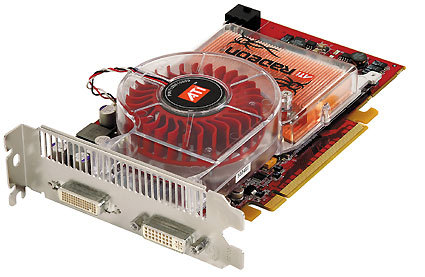ATI Puts NVIDIA's SLI in the CrossFire
Functional Principle: Dependence
At first glance CrossFire has some things in common with NVIDIA's SLI, first of which is a PCI Express motherboard with two x16-PEG slots. Although CrossFire is theoretically independent of the motherboard chipset, ATI says that it only works with motherboards based on the Radeon Xpress 200 CrossFire. Like Nvidia, ATI's aim is to sell customers a motherboard of its own making along with its graphics cards whenever possible.
Radeon X850 CrossFire Edition: recognizable by the special master card on the modified monitor output (left).
Similarities aside, there are many differences between the graphics cards. Besides a Radeon X800 or X850 standard graphics card (slave), the multi-VPU technology also needs a special X800 or X850 CrossFire graphics card (master). In contrast to SLI, the cards are not connected to each other via a small board, but merely via a monitor cable.
The standard Radeon card delivers the generated image to the CrossFire model via external digital cable. A specially developed and programmable chip mixes the images of both cards - instantaneously.
A "combiner chip" on the card mixes the results generated by the slave with those of the master and delivers the image to the connected screen. The combination is purely pixel-based. As the signals from the slave card are transmitted digitally via DVI with a very short cable, there theoretically should be no loss of image quality. The transmission and combination of images is in real time, which ATI claims will not lead to any delays in image formation in games.
Get Tom's Hardware's best news and in-depth reviews, straight to your inbox.
Current page: Functional Principle: Dependence
Prev Page Ingenious And Absurd Next Page A Cross Between Master And Slave

